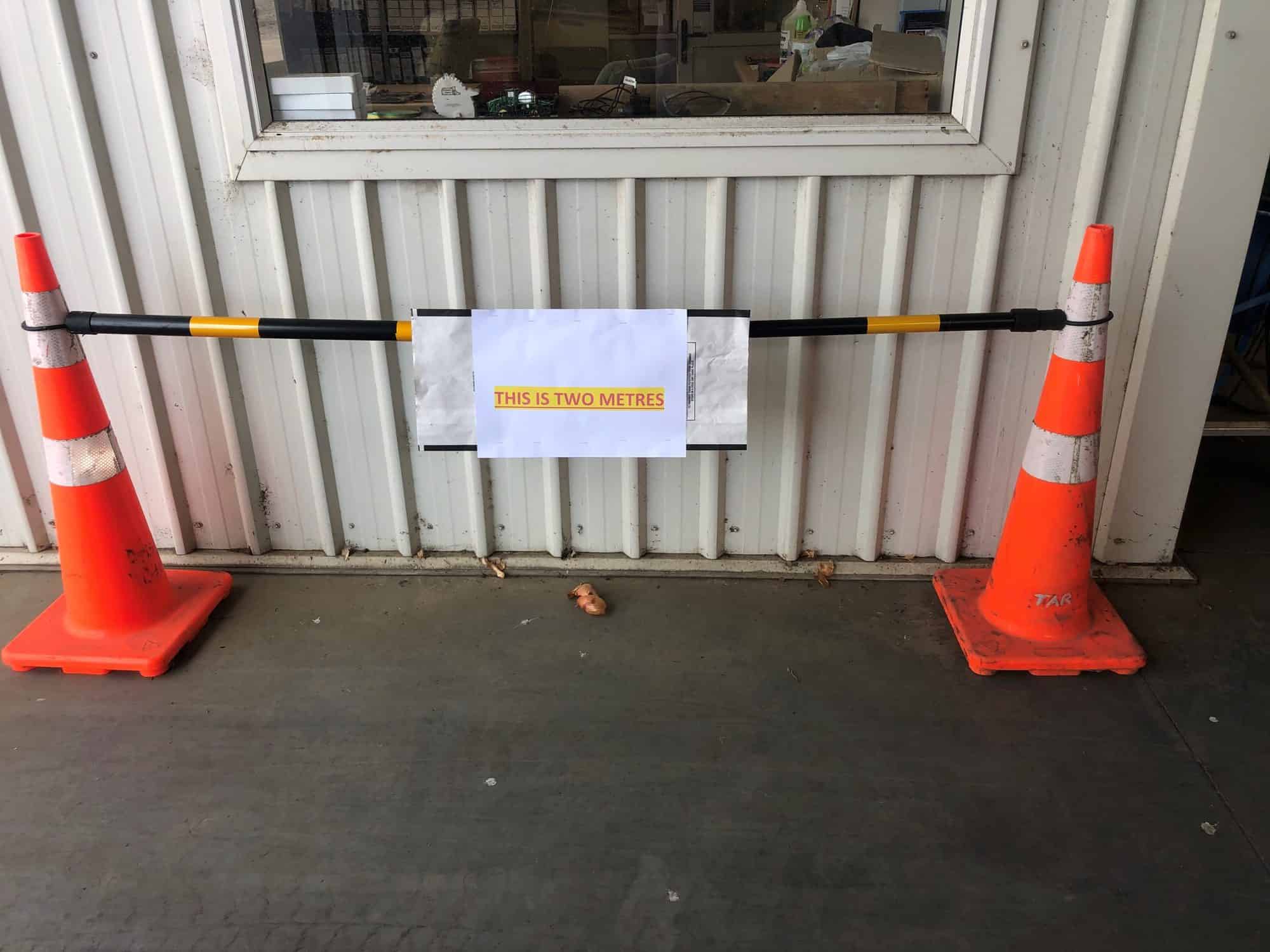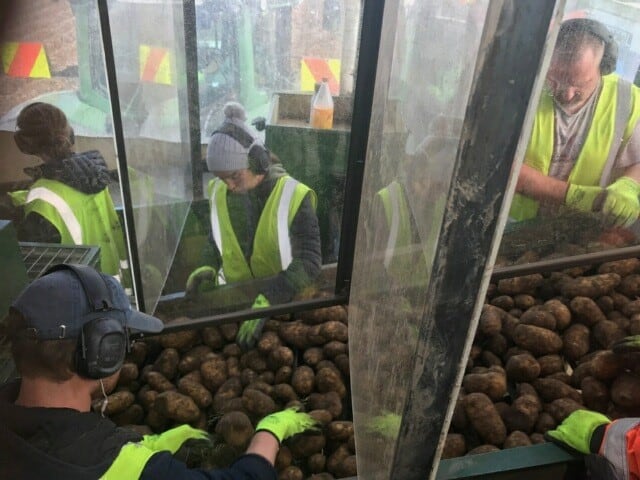POTATOES’ PANDEMIC RECOVERY: our industry’s role in New Zealand’s economic and social recovery, building on our strengths and playing a critical role.
The 2020 global pandemic crisis saw a rapid change to our on-farm management and to potato processing facilities. Our growers and employees adapted calmly and swiftly with innovative approaches to physical distancing and keeping their teams safe and well. Thankfully our integrated database meant that communicating fast-changing, sometimes daily responses, was very effective.

Peter Reynolds’ demonstrates 2 metre distance to staff and visitors.
The greater impact was not so much to the changes in worker health and safety, but to a slowing of production due to the restrictions on-farm, which resulted in a back-log of produce. As soon as the alert levels dropped, the surplus fresh was mostly moved into the supply chain.

The greater impact was in the food supply chain disruptions.
With hospitality closed for 2 months, both fresh and frozen fries saw a significant drop in volumes moving to market.
In addition fresh produce outlets were closed as well, which hindered fresh potato sales.
This meant some dumping of fresh potatoes, but also redistribution to food banks.
Thankfully in times of crisis, consumers turn to comfort food and therefore crisps maintained good sales, with shelves often emptying out in store.
Export of fresh potatoes has remained stable in volume but seen a significant drop in value from $800 per tonne at the start of 2020 to around $450 per tonne at present.
NZ exports of frozen fries remains pretty much where it was in 2019 for volume and minimal drop in value.
The frozen fries industry has been extremely concerned over the potential dumping of European frozen product, as the industry in Europe has seen a glut of 2.6 million tonnes due to their hospitality closures. Europe has defended itself in response to sturdy NZ media coverage of the concerns, however the NZ industry has pushed ahead with an application for anti-dumping to Ministry for Business, Innovation and Employment submitted on the 3rd July 2020. Minister Faafoi indicated sympathy in a meeting with PNZ and MBIE offered support if needed in evidence gathering and preparing the application.
According to PNZ analysis, dumping margins are currently anywhere between 95% to 151%. We expect these margins to increase. This will lead to price undercutting for the NZ industry of between 18% and 38%. The damage this will cause will destroy the NZ industry.
Given that Potatoes NZ has shown in the application to MBIE, that dumping exists and huge surplus inventories of frozen potato products exist; it is clear that the threat is real and an investigation into anti-dumping duties is warranted.
A separate Potatoes New Zealand commissioned Economic and Community Impact Report from Business and Economic Interest Limited (BERL), concludes that in the absence of a duty, potato processors would be forced to cut production and demand for potatoes from NZ growers would drop. Inevitably, this would lead to a loss of employment and a threat to the viability of some potato growing businesses. The imposition of an anti-dumping duty on dumped imports of frozen potato products, would help to maintain demand for New Zealand grown potatoes, and ensure the continuity of employment and business in the growing sector. A duty would mean that the potato growers would experience the same market conditions, including competition between themselves and fluctuations in market prices, as they did before the dumping occurred.
Dumping of imported frozen potato products into the New Zealand market will have a range of damaging effects. Steps should be taken to avoid these impacts. The BERL report can be read in full upon request and on the PNZ website https://potatoesnz.co.nz/news-info/resources/
The frozen fry sector of our industry accounts for 55% of our $1 billion dollar value and any threat to NZ process value will impact on the fresh sector as well. The New Zealand domestic market for frozen fries is historically about 85% NZ product and 15% imported, we don’t want that to ratio to change in favour of short-term cheap European imports.
In addition potato growers also grow other veges and the economic impact of reduction in the process market could be far reaching. Everything is connected and to ensure food security in a time of uncertainty and the likelihood of ½ million NZers being unable to afford to buy certain foods, we are looking for ways to ensure grower and consumer confidence.
This has included calling all growers during the early response weeks, at Level 3 & 4, as well as developing a pandemic recovery and transformation plan.
The Recovery and Transformation plan has been informed by growers surveys, economic reporting and a market research project.
You can view the market research on our website https://potatoesnz.co.nz/news-info/resources/
It is the first such report in 10 years and has been a very useful exercise in understanding consumer behaviour. We can see customers buy primarily at supermarkets and prefer fresh potatoes over processed. Consumers want to know more about the nutritional value of potatoes, the carb myths, as well as to celebrate the folklore of potatoes, with many of the qualitative interviews involving sharing of family traditions, old recipes and favourite varieties.
Plant and Food Research’s latest Fresh Facts also informed us that kiwis spent more money in 2019 on potatoes than any other vegetable.
Although our industry has felt the stress of the pandemic crisis, it is assuring to see evidence that potatoes are a definite, well-loved staple for consumers.
To maintain grower confidence and a secure food supply chain, it is essential that we remain agile during the recession and continue to address the long-term challenges of environmental regulation.
PNZ have come a long way in developing the Sustainable Vegetable Systems Project (SVS – formerly The Emissions Project) and have multiple workstreams underway, including field trials, Overseer evaluation and improvement and knowledge extension of new tolls in the future for growers across the vege sector.
At the same time we have aligned our submissions for Plan Changes and National Policy statements to reflect the data that will come from the SVS project. It is clear that the council changes are complex and region specific. This means that conveying the meaning of changes and the process for growers is an ongoing effort and will involve repeat regional visits, following up from those made in late 2019. The first of the 2020 visits is July 15th in Canterbury. Other regional visits will be listed on our events webpage.
One of the benefits to come from the SVS project is the input from Plant and Food Research’s social scientist Toni Whyte, who will inform SVS extension methods.
Grower engagement is critical to recovery and knowing what the latest social science research says about farmer/grower engagement will be invaluable.
Opportunities that arose from the challenges of the pandemic crisis were both the connection with all our growers, in our welfare calling rota and the connection with consumers in our market research.
Our latest values and volumes calculations for 2019 indicate an increase in area planted from 10,344 hectares to 10,417 hectares and an increase in the overall industry value to $1.1 billion dollars. This means we are still on target, at the end of the 2019 financial year, to achieve our strategic growth targets. The next 12-24 months will be the true test.
Our industry though shaken, is resilient and we aim to support the resilience of the whole vege sector, with our research in SVS and by continuing to feed NZers healthy local produce.
Our research, our approach to planning and our information systems will be the backbone of grower recovery and will contribute to NZ’s economic recovery.



